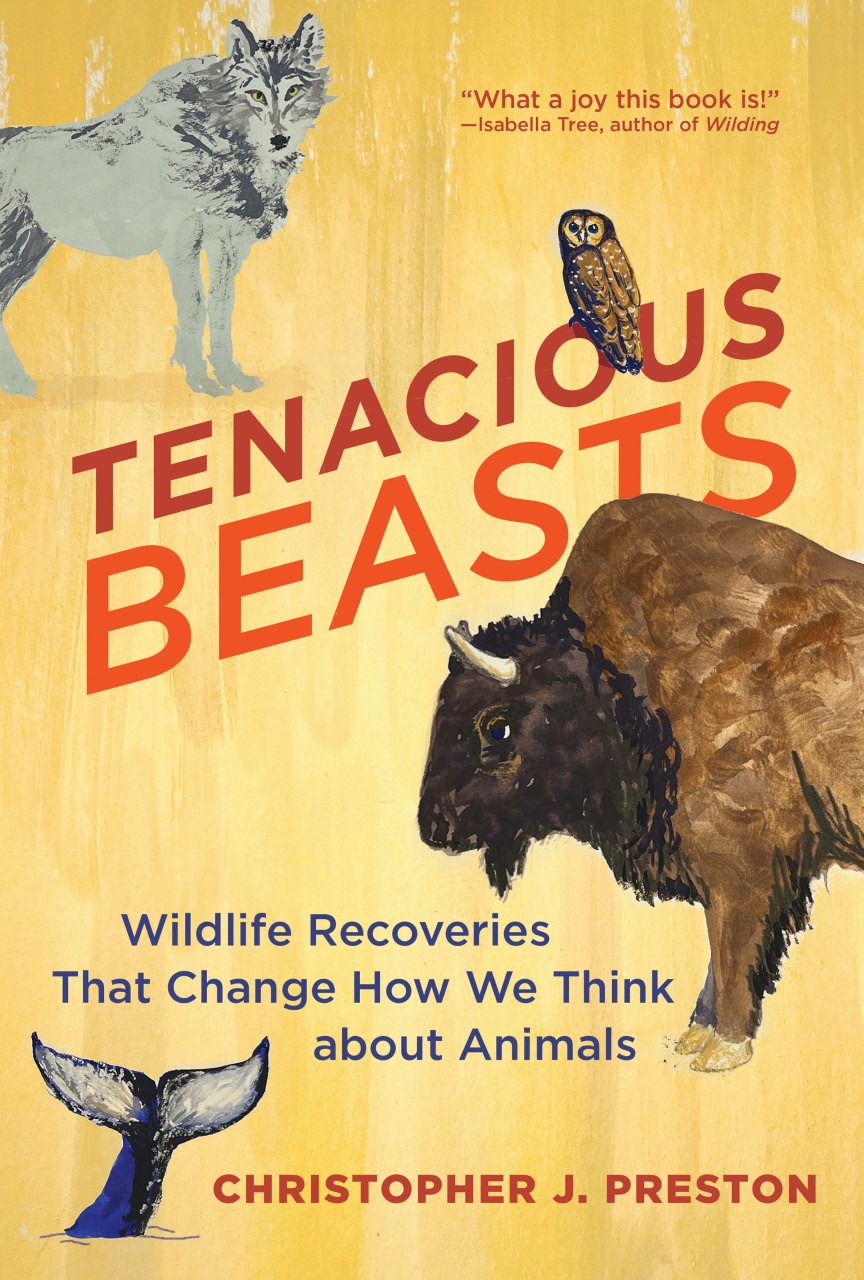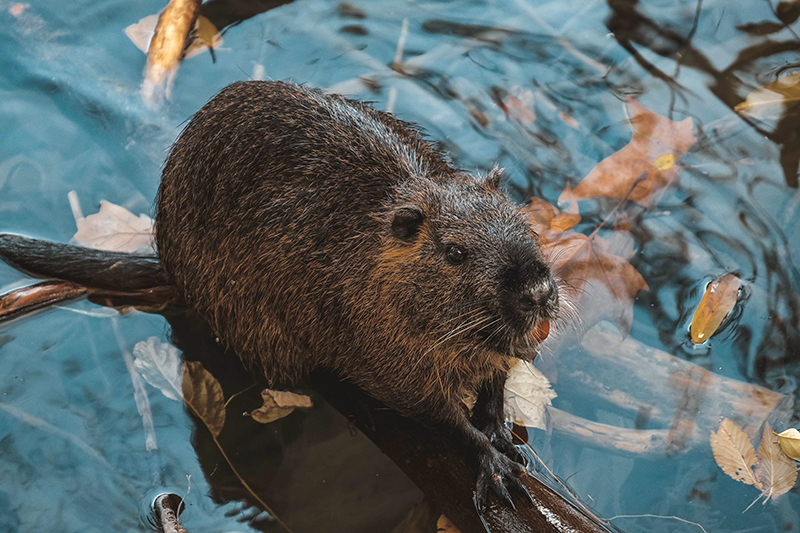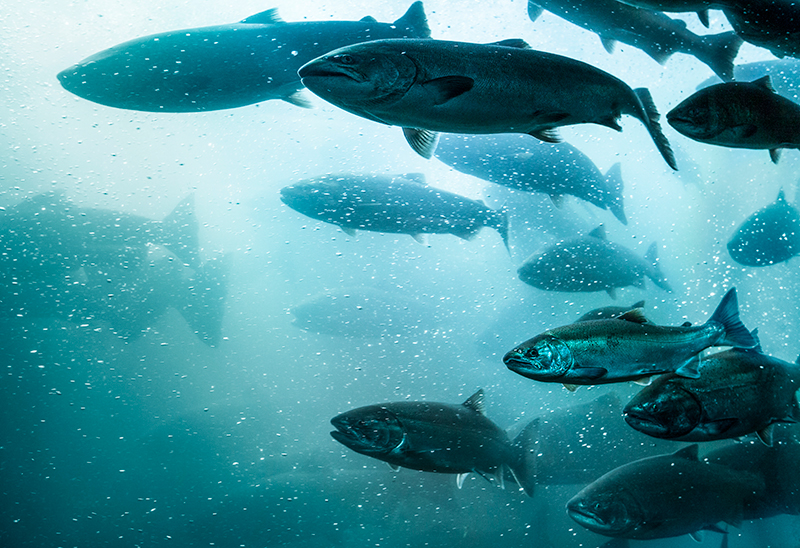Going Wild
Revitalizing Ecosystems to the Benefit of Man and Beast
The movement to rewild spaces long dominated by people raises questions and concerns. What can we learn about our role in the ecosystem?

Tenacious Beasts: Wildlife Recoveries That Change How We Think About Animals
Christopher Preston. 2023. MIT Press, Cambridge, MA. 328 pages.
It’s hard not to feel your own smallness when you stand face-to-face with the towering granite of the Sierra Nevada or the painterly green of a forest—when the features of the landscape are so vast that you know you can never see, in just one look, how far they wrap around the horizon.
Just as fascinating is the wildlife that grazes the nooks and crannies of these scenes—the bears and bison and beavers—the life we often do not see unless we pause awhile and look closely. Every marsh, mountain and valley relies on and is rich with the history of these creatures and the cultures they inspire.
Much of this life is under threat in the face of the climate crisis and other forces. In recent years, however, some species have been bouncing back. Why? And what can these recoveries teach us about our role in the ecosystem?
At age 22, Christopher Preston moved to Colorado from his home in southern England to further his education in environmental science and ethics. Today he’s a writer and a professor of philosophy at the University of Montana, researching the complexities behind a relatively new term in wildlife conservation: rewilding. In his latest book, Tenacious Beasts: Wildlife Recoveries That Change How We Think About Animals, Preston explores a series of successful wildlife resurgences to determine what they might teach us about conservation, culture and hope. The book, he emphasizes, is not meant to pacify us with flattering reassurances about the current state of the environment; the scientific urgency of biodiversity loss remains unchanged. Instead, Preston highlights nature’s resilience in order to determine how we can live alongside these animals, and how far our role must extend if we’re to be effective stewards of the planet.
The Rewilding Movement
The term rewilding has emerged in recent decades to describe a method of conservation dedicated to bringing wild species and biodiverse ecosystems back into human-engineered landscapes. Though coined in the 1990s, it gained popularity with the 2011 launch of Rewilding Europe, an organization dedicated to raising awareness and reintroducing wildlife species to parts of the continent where they had previously been driven out.
Broadly speaking, traditional forms of wildlife conservation tend to focus on the preservation of ecosystems in their current state, whereas the rewilding movement is more restorative in nature. It aims to go beyond current means of conservation by not just preserving what we have but restoring species to a regenerative ecosystem—a system with the ability to recover from damage.
This can be done passively, as in the case of leaving abandoned farmland or otherwise unmanaged areas to naturally regenerate vegetation, tree growth, and even some animals. But it can also be achieved through what is described as “trophic” or “translocation” rewilding, which involves actively removing infrastructural barriers to biodiversity (that is, taking away human barriers such as dams or manicured green spaces) and reintroducing keystone species to their native environments so the whole ecosystem can thrive.

The beaver, native to much of the Northern Hemisphere, is a keystone species—a species essential to the survival of its ecosystem.
In both instances, the goal is to create an ecosystem that is diverse enough to function independently, without constant management. For environmentalist George Monbiot, rewilding is about “undoing some of the damage we’ve caused, reestablishing species which have been driven out, and then stepping back. There is no attempt to create an ideal ecosystem, to produce a heath, a rainforest or a coral reef. Rewilding is about bringing back the species that drive dynamic processes, and then letting nature take its course.”
It’s worth noting that the term rewilding itself is not one-dimensional but encompasses a broad range of thought—much of which will require further research and caution before implementation. Researchers are still trying to define what responsible rewilding could look like, how it will complement other environmental strategies, and whether it’s more important, when rebuilding a native habitat, to consider a species’ genetic makeup or its function. Generally, however, rewilding has promising benefits for the environment, and many of the examples in Preston’s book show species’ potential to bounce back if we give them the range to do so.
“Amid a crushing wave of bad news, a handful of wildlife species have bounced back. . . . What they demand from minds unaccustomed to their presence is where some of the deepest puzzles lie. We need, in short, a new way to think about animals.”
Up and Down the Food Chain
Of course, the primary benefit of rewilding as a conservation strategy is its effect on biodiversity. Many wildlife populations that are critical to the health of an ecosystem have become fragile as a result of human development and are in desperate need of active reintroduction in order to thrive again. Their resurgence impacts the food chain in what is known as a “trophic cascade.” In a top-down model, the population of predators near the apex of a food chain, and the way in which they eat and behave, can affect the population density of not just their prey but, indirectly, of all other species in the ecosystem.
Many of the wildlife recoveries that Preston points to in his book—wolves, bison, wildcats, bears—are examples of trophic rewilding, where reintroducing a predator species is a starting point for ecosystem revival. He calls attention to how these animals are often misunderstood because of myths and fears about what makes them “predators.” By highlighting their recoveries, from the vast valleys of Yellowstone National Park to even the more densely populated parts of the Netherlands, Preston shows us what these creatures offer to the health of an ecosystem, and how possible it is to live safely alongside all kinds of wildlife. In the end, we do not have to let fear disrupt our ability to make space for a diverse environment.
But he also points out that rewilding doesn’t have to start from the very top of the food chain. Some species can support (or disrupt) entire ecosystems—on land and sea—from downstream. When two dams along Washington State’s Elwha River were built in the early 1900s, various native marine species dwindled, throwing off the balance in the food chain. When the dams were removed after nearly a century of use and years of deterioration, Preston notes, steelhead trout and chinook salmon regained over 30 miles of free-flowing river, allowing them to reach spawning grounds not visited for generations.

Pacific salmon make their way upriver during spawning season.
He says this project could eventually generate up to 400,000 salmon along the river, revitalizing the ecosystem in ways that ripple far beyond the water itself: The Olympic Peninsula relies on healthy fish populations for more than 70 percent of the nitrogen needed to sustain its coastal forests. Approximately 137 species in the Pacific Northwest depend on salmon for food, ranging from orcas to bears to birds. Some of these species help carry vital nutrients that salmon bring in from the Pacific to even the uppermost parts of 200-foot (60-meter) conifers—which in turn provide forest cover and root expansion that stabilizes the river bank and allows for cleaner water to filter from mountain to sea.
“It took thousands of years for the relationship between salmon and trees to develop. The result is an intricate, supportive system, poised to promote life.”
The effects of these recoveries have the potential to expand outward in complex ways that we simply cannot replicate by our own means. Preston says this is why, in part, it’s so important that we view nature as a partner rather than merely a resource. These natural communities also serve an important role in the climate crisis—wherein several species contribute to the range of such critical carbon sinks as kelp forests. He points out that some species, including whales, are themselves quite literally a carbon sink, each absorbing many tons of carbon before dying and falling to the ocean floor.
Cultural Implications
Underneath the environmental discourse lies a larger moral and cultural question: How should we think about our relationship both to nature and to each other?
When faced with seemingly insurmountable problems, it’s easy to retreat to our separate camps and steamroll past any challenging perspectives—especially when it comes to such complex issues as the climate crisis, which feel immovable in an economy-centered world and which impact different communities in different ways.
An example, Preston says, is the rural-urban divide that tends to creep up in restorative efforts such as rewilding. On the one hand, people want to see a variety of wildlife bounce back and thrive. But rural communities are concerned about how that might impact farmers who can’t afford to lose livestock to, say, a growing population of wolves. Despite the importance of wildlife recovery, these fears are valid. The cycles and unpredictability of nature can leave farmers more financially vulnerable to ecological threats than most of the urban population, and deterrence measures (for example, fencing) can be expensive. But people have found ways to meet the needs of both sides; for instance, Wolf-Fencing Netherlands and WikiWolves are volunteer organizations dedicated to helping farmers thrive alongside wolves by installing wolf deterrence measures (without harming the animals) free of charge.
Seeing to the needs of both conservationists and farmers is not always so simple. But to see the natural world flourish again takes compassion, patience, and a responsibility to connect with others, just as much as it takes a passion for the environment. In a world that often reduces issues to “us” and “them,” we can’t afford to antagonize any sort of “them” if we want to ensure progress.
“The prospect of losing a couple of sheep to a wolf is worrying. This vulnerability is not felt as acutely by urban people. . . . Urban dwellers need to recognize the reality of being vulnerable to natural cycles. They need to sympathize with those in the rural economy.”
This is one aspect of the division we tend to create, even in the most committed conservation efforts, between man and nature. Although rewilding is about stepping back from nature in one sense (to allow ecosystems to thrive), Preston says that learning to bridge this divide is an important aspect of the movement.
He acknowledges a growing culture in Europe, unaccustomed as it is to living alongside a larger range of wildlife. When he left his home in England for the rocky, wild terrain of the western United States, he admits he felt a constant uneasiness about the encounters one could have in the wilderness; bears, mountain lions, coyotes and moose seemed unlikely to be friendly neighbors. “To live safely in rural America, I assumed, you had to be Annie Oakley. And I had no gun.” Three decades later, he is eager to examine the lessons these animals can teach us.
For many Americans, learning to safely navigate a landscape in which coyotes howl and bears forage is a familiar fact of life. But even in a country supposedly brimming with these creatures, the underlying attitude for much of its settled history has been that people and wild animals should live well apart from each other. How has that seeped into even dedicated conservationists’ thinking? And what can nature’s resilience teach us about living in partnership with both the biosphere and the human cultures it sustains?
The idea that man and nature must be separated for their own good is largely European. Throughout history, it has proven detrimental to many cultures, especially those of the Indigenous peoples who have depended on the wildernesses of North America, Africa, Australia and more for centuries.
As European settlers arrived, they brought with them modern scientific thinking based on a mechanistic view of life. According to Preston it was the father of modern philosophy, Rene Descartes, who proposed that “everything could be explained mechanically. There was no pain in the animal kingdom. Its residents had no value other than the ways they satisfied human whim.”
This came in stark contrast to the values of Native American and other Aboriginal tribes, who had long respected and tended to the ecosystems surrounding them. Preston spends quite a bit of time in his book exploring the decline of bison in the 19th century, a near-extinction event that heavily impacted America’s native population. Native American culture, having been deeply intertwined with nature for millennia, directly suffered when various factors converged early in the 19th century to diminish the bison population in the Great Plains of the West. Central to Preston’s point is that when the European newcomers entered the equation, the balance between the Indigenous peoples, their land, and the native wildlife was overthrown. In the latter half of the 19th century, European Americans accelerated the bison’s decline as a way to force Indigenous tribes onto reservations to make way for white settlers. And even as Western cultures shifted toward a sobering realization of the need for preservation at the turn of a new century, Indigenous groups were kept at the sidelines.
When the first national parks in the United States were established, iconic conservationists John Muir, Theodore Roosevelt and others championed the idea of a wild refuge free from human influence for the sake of preservation. To this day, national parks all over the world serve as an important anchor in the world of conservation and education. What some of these naturalists envisioned, however, was a completely uninhabited fantasyland—so untouched by the hand of humanity that any peoples within it would make it unworthy to be called “wilderness.”
This ideal was not only naive, it was devastating to Indigenous peoples who had historically relied on and tended the landscape around them—from the forests of the Tongass in Alaska to the steep ranges of the Sierra and beyond. So when the Elwha dams went up in the early 20th century, the salmon weren’t the only ones who suffered. The spawning grounds that the Lower Elwha Klallam Tribe had relied on and nurtured for generations were an important part of their culture and their livelihood. It took decades for the concerns of the tribe to be taken seriously enough to remove the dams.
The neglected side effect of Muir and Roosevelt’s political influence in the world of conservation was that Native American tribes were once again pushed out of their land, this time to make way for idealistically dispeopled parks. Still today, this idea informs the primarily Eurocentric voice of conservation science.
“Knowledge is not just academic. The knowledge that comes through being in one place all this time is different than when somebody comes in and studies it for five years, or even twenty years.”
Preston quotes wildlife ecologist Hugh Jansman to point out that “‘wildlife management . . . is really an application of people management.’ And this is not only about what people do. It’s about what they think.” To be effective stewards of the earth, we need not just a sense of preservation and compassion for all the animals that thrive within it, but also a willingness to understand other people. Human culture is deeply intertwined with the culture of nature, and both require a sense of empathy and partnership that extend beyond our own interests.
Active Restoration
The natural world is composed of incredibly intricate webs of ever-changing life—intricacies that make our biosphere delicate but also extraordinarily resilient in the face of collapse.
This dichotomy can make it difficult for scientists to agree on what good stewardship of the earth means. Climate engineering tactics—such as controlled dumping of iron nutrients directly into the ocean to stimulate the growth of phytoplankton and, by extension, salmon populations—have proven only partially effective compared to the active restoration of wildlife populations. More controversially, their effects on the general ecosystem are still unknown. But Preston says we can learn from the thoughtfully created systems of wildlife by rekindling the spaces needed for them to flourish alongside us.
Each chapter in Tenacious Beasts presents a new way to think about wildlife and preservation. But throughout the book, Preston consistently comes back to the way we separate ourselves from the natural history around us, asking how necessary that separation is. Many questions arise in the process: Can we, as a species, be humble enough to recognize the brilliance of nature beyond ourselves, and to treat what is around us as a partner rather than something to simply extract from or reengineer? Do we possess the empathy to listen to the often neglected and underrepresented voices in such global issues as conservation?
We have a unique place in the natural world, but stories like this can help us consider how far our idea of love and concern extends even in the most scientific spaces, and whether dominance on the earth is the same as domination.
